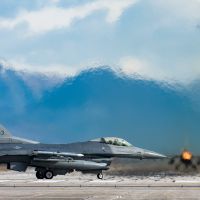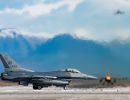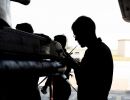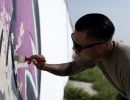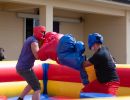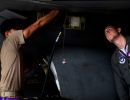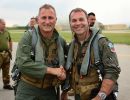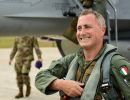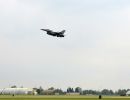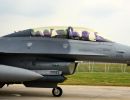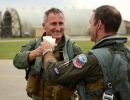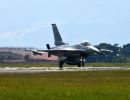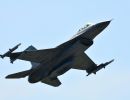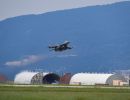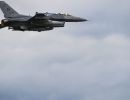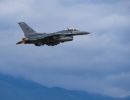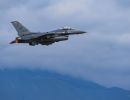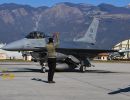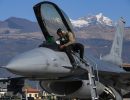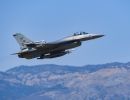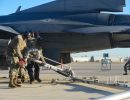But in an F-16 fighter jet, bluesuiters are only 30 minutes away from the bloody civil war in Bosnia -- a sobering fact that has helped make Aviano an Air Force boom town in the past few years.
In support of Operation Deny Flight, which began just over two years ago so NATO forces could patrol the U.N.-imposed "no-fly" zone over Bosnia, the once-tiny base has gone from 1,500 to more than 3,000 troops--plus their family members. Literally bursting at the seams, it's also turned into Europe's busiest flight line.
"We can get up in the morning, go to church, have brunch with the wife and baby, get called into work, go drop bombs over Bosnia, and be back at home in time for supper," said Lt. Col. Stephen L. Hoog, 555th Fighter Squadron commander. "That's happened to many of us [pilots] at one time or another. Two days after our squadron stood up [April 8, 1994], we dropped our first bombs. It's the reality of war."
Even in the serenity of the Italian Alps, it's hard for service members and their families to escape the horrors of armed conflict. That point was driven home June 2 when Bosnian Serbs shot down the F-16 carrying Capt. Scott O'Grady, who was rescued six days later by NATO search and rescue forces. Then there's the constant news reports of unthinkable atrocities by Bosnian Serb soldiers against Bosnian Muslims, to include "ethnic cleansing" through mass killings, rape and torture.
"A lot of the squadron wives were a little tighter jawed after O'Grady was shot down," Hoog said.
Two squadrons of F-16 fighter-bombers, each with 12 planes, are based at Aviano as part of NATO's monitoring of the "no-fly" zone--the 555th and the 510th FS. Aviano is technically under Italian command, and Spanish and British flight crews also are stationed there. Together with TDY aircraft, more than 100 planes call the flightline home.
While it is U.S. policy to take no side in the war as a combatant and continue to press for a negotiated peace, Defense Secretary William Perry said recent Bosnian Serb actions--the shelling of Sarajevo, taking U.N. peacekeepers hostage and shooting down an American F-16--are self-destructive, barbaric acts.
They are a "strategic blunder," causing the international community to strengthen its resolve against the Bosnian Serbs, Perry said in a speech to the Armed Forces Communications and Electronics Association Exposition in Washington.
Two other elements Perry cited as part of U.S. policy in Bosnia are keeping the war from spreading and reducing violence inflicted on innocent civilians.
In line with this charter, NATO recently extended its threat of air strikes against Bosnian Serbs if they attacked any of the remaining "safe areas" in Bosnia. "Safe areas" include Gorazde, Tuzla, Bihac and Sarajevo. Serb forces wasted no time testing the world's will and launched attacks against the "safe areas" of Zepa, Bihac and Sarajevo. At press time, two other "safe areas," Gorazde and Tuzla, remain vulnerable to Serb attack. To complicate things even further, Croatian forces entered the fighting in early August.
After NATO's threats and continued Serb aggression, news media reports speculated that air strikes are imminent. (NATO's bombing campaign began in late August. See page 10 for more on the strikes.)
"I tend to be a little underwhelmed by news reports," Hoog said. "We're always at the near-panic stage, then sit around for five days. We've been spun up and spun down so many times in the past year, that it takes its toll on morale."
Even so, most pilots view Deny Flight duty as the envy of the tactical Air Force.
"This is the real thing--where you find out if you've got what it takes," said Capt. Anthony J. Roberson, the first pilot to sign into the 555th, excluding the squadron commander. "All the pilots I talk to want to be here; although, they are just seeing the glory side of it on CNN and don't have to see what we go through on a day-to-day basis."
Roberson has flown more than 60 missions into Bosnia, where tracer fire quickly turns thoughts of glory into a humbling feeling of vulnerability.
"When you're 25,000 feet in the air and you're watching a ground fight or a tracer round pointed at your jet, you realize the stakes are definitely high," Roberson said. "You can be here today, gone tomorrow. It's not something you can glamorize or shrug off."
He admits this is one job where he takes his work home with him.
"I don't believe you can have a normal family life in this environment," the fighter pilot said bluntly. "You can go home at night and pretend everything's status quo, but Deny Flight consumes your thoughts. If you just got shot at or your buddy did, you have to live with that. You just can't leave that behind at work."
For Roberson's wife, Janette, not having a "normal" family life doesn't mean they can't have a happy family life.
"I think about what can happen, but I refuse to let it preoccupy my thoughts," said Janette, who works in the base family advocacy office. "I say a prayer every day that Anthony will come home safely, then I try to keep myself busy. If I let my imagination get carried away with a lot of 'what ifs,' I'd probably go crazy. You have to learn to cope and stay flexible."
She does that by spending a lot of time with other wives in the same situation, skiing in the Alps or going on a "shop till ya drop" trip to Venice or other nearby towns.
"Our husbands work a lot of hours and get recalled often, so if you waited around to do everything with them, you'd be sitting at home a lot twiddling your thumbs," Janette said. "I guess I have a couple advantages though. I'm an Army brat who grew up in this type of environment. Plus being from Colorado, I'm biased. I love the mountains."
Even her positive attitude was tested when O'Grady was shot down.
"They let us know someone was shot down, so we wouldn't hear it on CNN first," Janette said. "But they hadn't released the name yet, and Anthony wasn't home. My first reaction was probably the same as all the other wives. 'Who? My husband?' Luckily we have a great group of commanders who keep an excellent network of information flowing."
While most bluesuiters consider Aviano a great assignment and have learned to cope with the stresses of a real-world mission, it didn't prevent them from giving Deny Flight the dubious nickname "Deny Life."
 For SrA Julie Eck, loading munitions at Aviano AB is more intense that anywhere she's been before. "This is the real thing. Live ammo, live targets," she said.
For SrA Julie Eck, loading munitions at Aviano AB is more intense that anywhere she's been before. "This is the real thing. Live ammo, live targets," she said.
"It's kind of a joke around here," said SrA. Julie C. Eck (above), a weapons loader with the 555th. "I don't know who started it, but pretty much everyone calls it that now. It comes from working long days and long hours."
She explained how at times they've worked nearly 20 days straight, 10- to 14-hour days. "And it seems like every time you try to plan anything, you get recalled.
"But war is unpredictable, and we've made a commitment to the Bosnians. Too many people have lost their homes and their families. Even though it's a lot of hard work, the satisfaction of knowing you may make a difference is worth it."
While airmen concentrate on the mission, improvements continue to be made at the overcrowded base.
Three years ago about $4 million was being pumped into Aviano. With the influx of people for Deny Flight and the natural buildup of the base as it becomes the strategic southern region fighter presence for Eastern Europe, that number soared to $26 million this year. Things like more parking, new dorms, larger facilities and better supply systems are on the way. But the bottom line is the population explosion overwhelmed the base, and improvements take time.
"There wasn't a lot of time to plan when they dropped us all here, so you have to expect some inconveniences," said SSgt. Steven S. Simons, an F-16 mechanic who lives 45 minutes from the base with his wife, Michelle, and two sons, Sean, 5, and Ian, 2. "A lot of the facilities are too small or out of date, and supplies run out quickly. One of the first rules you learn is 'if you see it, buy it.' Because if you wait, it won't be there when you go back."
For Michelle, it's not so much the base as the drive to the base that gets to her.
"There's not a lot of housing close by," she explained. "Living 45 minutes from the base is no big deal in the States, because you have a supermarket on every corner. But when you have to go to the base to take your kid to school, grocery shop, pick up the mail, and almost every other errand you can think of, that hour-and-a-half round trip gets tough."
On a three-year tour at Aviano, the Simons say any short-term inconveniences they have to go through are worth it.
"This area makes up for almost anything," Michelle said. "We love Italy--the culture, the friendly people. We plan to stay longer. Aviano has the charm of a small-town base."
And the excitement of a boom town.


